An important issue
in global food
industry
Azadeh Nikfarjam
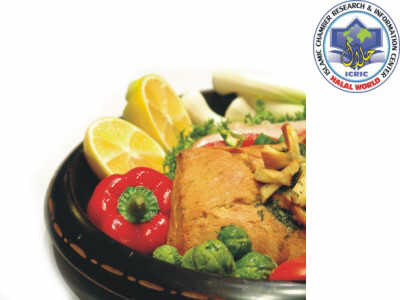
Food Industry
|
An important issue
|
 |
As Islam has program for controlling human being social life, it has considered a number of plans and programs for his/her personal life which is the list of criteria of “Halal”, including eating, drinking, clothing, dressing, applied tools in life. Each should be sealed by Halal on the basis of Islamic Shariah. Islamic community, has safeguarded this independent system, and regulated a special life according to such Shariah resulted from the divine inspiration within the human community during fifteen centuries. Now, in the globalization age, development of such standard Halal criteria in all aspects of life sponsoring by standard monitoring centers is a must, so that all product is presented by a special brand to guarantee the consumers’ tranquility of mind at global stage and all producers should be committed to accept such system of monitoring. The global Halal food market is on the threshold of major developments that hold the promise of rapid and sustained growth. With the Halal food market currently accounting for as much as 12 percent of global trade in agri-food products, major growth will generate growth opportunities throughout the agri-food industry. Many reports on the Halal market focus on meat, but products sold under the Halal label cover virtually every agri-food product plus non- food products such as cosmetics even cloths and…. A very wide range of products are labeled Halal such as sauces, bottled water, tea, coffee and fruit drinks. Determining the “halalness” of a product goes beyond ensuring that food is pork-free. Carnivorous animals, amphibians (frogs and mangrove crabs) and all insects xcept grasshoppers are not Halal. Intoxicants in any form are also off-limits. Meat from permissible animals such as poultry and cattle must be slaughtered in accordance with Islamic rites to render them Halal. Halal food also adheres to stringent standards in hygiene and sanitation. The certification of Halal food has been conducted in Malaysia since 1982 by the Department of Islamic Development of Malaysia (JAKIM). The Codex Alimentarius Commission, which is responsible, under the United Nations, for regulations of food preparation globally, has cited Malaysia as the first country in the world in terms of justification of Halal food. Participants at the world Halal forum hope to devise unified standard and a common labeling system for all Halal products. Halal food certification refers to the examination of food process, from the preparation, slaughtering, ingredients used, cleaning, handling and processing, right down to transportation and distribution. The concept of Halal food is truly from the farm to the table, and must be nutritious and prepared from permissible ingredients in a clean and hygienic manner. Logistics and packaging are vital too. Non-Halal and Halal goods must also be kept separately in the storage or during transportation and distribution in order to prevent contamination. The success of Halal food industry, in both domestic and export markets, depends on a broad range of policy developments including those related to the law and regulations, support services and infrastructures, such as human resource development, finance, as well as marketing and promotional efforts and also add value through providing services such as Halal management, logistics and finance. Halal business and Islamic finance have integral roles to play in the development of a strong Halal economy. This new idea ensures Halal-related businesses are ‘100 percent Halal’. Islamic source of funds also promote the growth of a global potential that is, in reality, in dire need of Muslim entrepreneurs. To ensure that the whole production process is Halal, the source of the financing should also be from a Halal source, i.e. using Islamic banking services. Halal business cover a wide span of economic activities, from farming to manufacturing and processing of food, from selling food in stalls by the road side to the import and export of commodities between nations, from car manufacturing to infrastructure building. These activities rely substantially on the financial market to facilitate their transaction, and Islamic banking and finance industry is the only natural ally to all types of Halal activities. The world Muslim population is approaching 1.6 billion people, mainly residing in the Middle East, in outheast Asia and in Central Asia. Muslims are expected to account for 30 percent of the world’s population by 2025. If every Muslim spends just $1 a day on Halal food, the otal would come up to $584 billion a year.
The value of Halal food trade annually is $2100 billion
which shows the high potentials of Halal food trade in the world. Malaysia
has been globally recognized as the world’s Halal food hub and it’s the
forerunner in this industry. Malaysia is not the only country that covets
Halal markets. Stiff competition abounds from both Muslim and non-Muslim
nations, including Brunei, Thailand, the Philippines, Australia and New
Zealand. United Kingdom and France are now the next important producers after
Malaysia.
Key Halal markets in Muslim countries:
|
Algeria (33.1 ) |
Qatar(0.6 million) United Arab Emirates( 4.6 million) Indonesia(226.7 million) Lebanon(3.8 million) Saudi Arabia(24.9 million) Yemen(21.9 million) Iran(71.1 million) Malaysia(26.6 million) Syria(18.9 million) |
Key Halal markets in non- Muslim countries:
|
India(140million) |
France(6 million) Germany(3 million) United Kingdom(1.5million) Canada(800000) |
Global Halal Market:
The global market for Halal food products presents many opportunities for
suppliers. Opportunities exist across a wide range of products covering almost
all food categories. Traditionally, the Halal market has been seen as
consisting primarily of meat products but more and more consumers are seeking
Halal certified products across the entire food industry. Given the
competitive nature of the global Halal market, potential new entrants should
consider matching their product offerings with particular markets. Some
industry experts suggest that potential entrants should think in terms of
“Halal plus”, meaning enterprises should ask what it is they are offering that
is not already available in the target market. Simply entering a market with
offering similar to those currently available is not likely to succeed.
Exporters’ chances of success will likely be increased by introducing a new or
differentiated product to a target market. While the range of potential
markets is very wide, experts seem to agree that the most promising are the
fast growing economies of the Middle East, especially members of the GCC,
ASEAN, Western Europe, and the US. Europe is seen as an important market for
Halal products on the basis of higher purchasing power rather than population
size. Furthermore, non- Muslims’ willingness to purchase Halal food adds to
the attractiveness of the European markets. In particular, one study has
indicated that Dutch consumers in general are willing to purchase Halal
products on the basis of the belief that such products are safe. France is
the largest market for Halal products among non-Muslim countries. The value
of the French market for Halal products has been estimated at over $13
billion. The port of Rotterdam is attempting to become recognized as the key
Halal entry point for the European market. The port intends to indicate one
warehouse solely to Halal products, and is thereby going a long way towards
ensuring that Halal products do not come into contact with non-Halal
products. In some European countries, the size of Muslim households is
declining and leading to a reduction in the importance of formal family
meals. In addition, more homes are being equipped with extra freezing
capacity and microwaves ovens. Both trends are increasing the importance of
convenience foods.
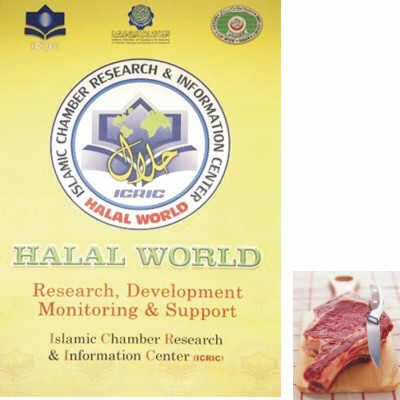
The main European Halal food producing countries are: United Kingdom, France
and Germany. The US markets for Halal products is estimated at $12 billion
annually and domestic sales are growing. Estimates on sales growth are
difficult to obtain, but US sales of Halal food have increased by more then 70
percent since 1995. Australia is a major supplier of Halal products, with
exports to over 70 countries. Australia’s competitive advantage in the global
Halal market stems from its reputation as a producer of safe, disease-free
food products. It is the first non-Muslim country to place Halal
certification under legislation, although opinions differ on the importance of
the legislation. Asia has the largest Muslim population of any given region,
but the population has modest per capita incomes, and hence lower total food
consumption than other areas. For example, high population countries like
India and Pakistan have relatively low consumer incomes and consequently
exhibit lower per capita protein consumption. Despite lower income levels,
this region has been at the forefront of capitalizing on the growing Halal
market. Malaysia, Thailand, Singapore, the Philippines, Brunei, China and
India have all taken steps to tap into the global Halal market. Malaysia, in
particular, has designs on becoming an international Halal hub and its
government has taken a number of measures to support that objective including
the establishment of the Halal development corporation. The Singapore food
industry has also taken a number of steps toward becoming a Halal hub,
including an advertising campaign in the Middle East. Thailand has moved to
become a recognized Halal center of excellence in science and testing. Brunei
is co-operating with Australian companies in order to combine its role in the
Muslim world with Australia’s track record in safe, high quality food
production. The Chinese Halal industry is growing and is expand its role in
the global market. At the moment, the key advantage of the Chinese Halal
industry is access to cheap labour.China recently signed a Memorandum of
understanding with the European Commission (EC) and already has several
ECapproved companies ready to export Halal products to European markets.
Indian exporters are attempting to gain recognition through the achievement of
HACCP, ISO and Halal certification. While Asia is a market of interest,
simply because of its size as the largest Muslim region, it must be noted that
key players in the region are taking steps to become key suppliers or
certifiers. Their efforts to date have already expanded beyond their own
regional confines and they will surly be major players in the global Halal
market. On the positive side, as markets with limited agricultural
capabilities attempt
Agri-Food imports by main Halal markets (2006):
| country | Population (million) |
Agri-Food imports from world (US$) |
|
Algeria |
33.1 |
4.1 b |
|
Bahrain |
0.8 |
522 m |
|
Egypt |
72.6 |
4.0 b |
|
Indonesia |
226.7 |
6.2 b |
|
Iran |
71.1 |
3.2 b(2005) |
|
Iraq |
26.9 |
2.0 b(est.) |
|
Jordan |
5.8 |
1.5 b |
|
Kuwait |
2.5 |
1.0 b(est.) |
|
Lebanon |
3.8 |
1.4 b(est.) |
|
Malaysia |
26.6 |
6.6 b |
|
Morocco |
31.8 |
2.3 b(2005) |
|
Oman |
3.1 |
1.0 b(2005) |
|
Qatar |
0.6 |
663 m(2005) |
|
Saudi Arabia |
24.9 |
8.7 b(2005) |
|
Syrian Arab.Rep. |
18.9 |
1.4 b(2005) |
|
Tunisia |
10.1 |
1.2 b(2005) |
|
Turkey |
72.5 |
3.1 b |
|
UAE |
4.6 |
4.6 b(2004) |
|
Yemen |
21.9 |
0.9 b(est.) |
|
Total |
658 |
53 b |
to become international certifiers and Halal hubs, they will surly be looking for inputs to meet the needs of a growing industry. Middle East countries, especially members of the cooperation council for the Arab States of the Gulf (GCC), have higher incomes and consequently higher per capita rates of consumption. In addition, the region must import 80 percent of its food requirements. Saudi Arabia and the United Arab Emirates (UAE) are seen as the most important import markets in the region. Currently Brazil is the largest exporter to the two countries followed by the EU and the US. Turkey, a large market in itself, and is leading the supply to European markets, particularly to EU countries with large Muslim population such as France and Germany. Egypt was recently seen as the most important market for Halal food in North Africa. There is no denying the size and importance of the Halal food market. Estimates on the size of the global Halal market range from $500 billion to $2 trillion. The conservative value of an annual $500 billion is a reasonable estimate of global spending on Halal food, as it assumes per capita spending on such products to be approximately $300 per year. Global trade in Halal food products is estimated to be $80 billion, or some 12 percent of total trade in agri-food products. With expected increases in both population and incomes of Halal consumers, this percentage is certain to increase. Furthermore, with the Muslim population projected to account for 30 percent of the world’s population by 2025, Halal food could easily account for 20 percent of world trade in food products in the future.
Beef and Veal imports by Major Halal Markets:
| Reporting Countries |
US Dollars | % Share | |||||
| 2004 | 2005 | 2006 | 2004 | 2005 | 2006 | %Change 2006/2005 |
|
|
Algeria |
149,232,934 |
180,058,952 |
145,066,005 |
13.69 |
14.16 |
23.18 |
-19.43 |
|
Bahrain |
10,080,105 |
10,513,843 |
11,548,545 |
0.93 |
0.83 |
1.85 |
9.84 |
|
Egypt |
198,795,186 |
319,731,721 |
0 |
18.24 |
25.14 |
0.00 |
-100.00 |
|
Indonesia |
52,382,568 |
74,736,568 |
84,837,014 |
4.81 |
5.88 |
13.55 |
13.51 |
|
Iran |
91,972,158 |
51,807,009 |
0 |
8.44 |
4.07 |
0.00 |
-100.00 |
|
Iraq |
12,073,942 |
9,919,309 |
15,082,036 |
1.11 |
0.78 |
2.41 |
52.05 |
|
Jordan |
37,634,077 |
49,180,166 |
63,096,152 |
3.45 |
3.87 |
10.08 |
28.30 |
|
Kuwait |
49,295,104 |
80,914,142 |
40,153,680 |
4.52 |
6.36 |
6.42 |
-50.37 |
|
Lebanon |
51,495,000 |
0 |
0 |
4.73 |
0.00 |
0.00 |
|
|
Malaysia |
182,355,544 |
198,765,547 |
190,319,123 |
16.73 |
15.63 |
30.41 |
-4.25 |
|
Morocco |
2,336,365 |
3,057,315 |
3,632,511 |
0.21 |
0.24 |
0.58 |
18.81 |
|
Oman |
20,971,465 |
23,046,729 |
0 |
1.92 |
1.81 |
0.00 |
-100.00 |
|
Qatar |
6,230,837 |
12,066,632 |
0 |
0.57 |
0.95 |
0.00 |
-100.00 |
|
Saudi Arabia |
130,390,339 |
131,278,351 |
0 |
11.97 |
10.32 |
0.00 |
-100,00 |
|
Syria |
0 |
0 |
0 |
0.00 |
0.00 |
0.00 |
|
|
Tunisia |
22,862,302 |
22,706,922 |
0 |
2.10 |
1.79 |
0.00 |
-100.00 |
|
Turkey |
75,071 |
0 |
0 |
0.01 |
0.00 |
0.00 |
|
|
UAE |
67,607,424 |
98,865,799 |
71,661,808 |
6.20 |
7.77 |
11.45 |
-27.52 |
|
Yemen |
3,926,655 |
5,140,765 |
527,959 |
0.36 |
0.40 |
0.08 |
-89.73 |
|
Total |
1,089,717,076 |
1,271,789,770 |
625,924,833 |
100,00 |
100,00 |
100,00 |
-50.78 |
| Reporting
Countries import statistics (Partner country: World) Iraq, Kuwait, UAE
and Yemen based on exporting country data. Source: Global Trade Atlas |
|||||||
The most important reasons drive the Global Halal Food
markets:
-Growth in the Muslim population, the primary market for Halal food. -Rising
incomes in primary markets for Halal food. - Increasing demand for safe, high
quality food in primary markets. -Increasing demand for greater variety in
primary markets. - Incidents of food marketed as Halal but failing to meet
Halal requirements has spurred demand for genuine Halal products. Gateways to
participation in the Global Halal Food Market: -Production or processing
-Exporting
-Retailing
-Providing inputs to the processing sector.
-Supplying hotels, restaurants and institutions.
-Private label production
-Transportation or logistic support Management services.
-Consulting
-Training
-Marketing or trade promotion
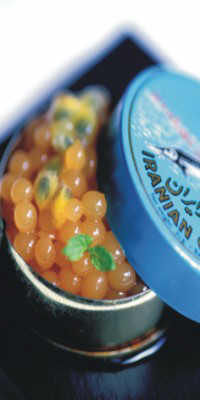
Iran Halal market:
The Halal brand for Iranian products was granted and one logo was
determined. Allocation of Halal brand will help decrease the cost of goods
exchanges and increase (OIC) has embarked to study and research on the
subject to meet this need in Muslimworld. ICRIC also has embarked to adapt a
monitoring system in “Halal Product” including “Halal Food” through adding up
the implemented activities in this ground. ICRIC wishes to register the
“Halal” brand as well as to develop an especial monitoring system for it by
the help of Halal producers in Muslim world. Moreover ICRIC wishes to support
the development and expansion of such Halal product by setting up a number of
fairs and exhibitions, and in its next steps, it could bring about other kinds
of supports for such manufactures at the global stage. Halal standard and
label will make shopping easier for consumers and it will also make it easier
for food producers to enter the Halal market. By following certain rules,
producers will be able to obtain a Halal certificate that is recognized
worldwide, allowing them to expand their sales opportunities. Considering the
export of Iranian products, using of Halal brand is necessary and cause the
world market to be inclined to Persian Foods. In the last year, the export of
Iranian food products was $260 million and due to the high potentials of
Iranian companies in producing Halal products, it is predicted that food
export will be increased over $700 million.
Poultry imports by Major Halal Markets:
| Reporting Countries |
US Dollars | % Share | |||||
| 2004 | 2005 | 2006 | 2004 | 2005 | 2006 | %Change 2006/2005 |
|
|
Algeria |
541,280 |
685,111 |
395,806 |
0.05 |
0.05 |
0.08 |
-42.23 |
|
Bahrain |
33,335,183 |
31,824,594 |
33,734,353 |
3.20 |
2.35 |
6.50 |
6.00 |
|
Egypt |
395,752 |
391,881 |
0 |
0.04 |
0.03 |
0.00 |
-100.00 |
|
Indonesia |
1,310,309 |
4,121,218 |
5,228,266 |
0.13 |
0.30 |
1.01 |
26.86 |
|
Iran |
14,360,374 |
0 |
0 |
1.38 |
0.00 |
0.00 |
|
|
Iraq |
25,643,575 |
27,955,449 |
25,473,078 |
2.46 |
2.06 |
4.91 |
-8.88 |
|
Jordan |
15,239,759 |
18,493,618 |
21,547,814 |
1.46 |
1.37 |
4.15 |
16.51 |
|
Kuwait |
115,298,626 |
185,780,382 |
121,344,301 |
11.05 |
13.72 |
23.38 |
-34.68 |
|
Lebanon |
6,646,000 |
0 |
0 |
0.64 |
0.00 |
0.00 |
|
|
Malaysia |
25,428,181 |
27,149,879 |
26,875,750 |
2.44 |
2.01 |
5.18 |
-1.01 |
|
Morocco |
1,801,515 |
2,600,255 |
2,402,215 |
0.17 |
0.19 |
0.46 |
-7.62 |
|
Oman |
55,989,813 |
65,172,663 |
0 |
5.37 |
4.81 |
0.00 |
-100.00 |
|
Qatar |
44,660,643 |
38,070,869 |
0 |
4.28 |
2.81 |
0.00 |
-100.00 |
|
SaudiArabia |
455,871,575 |
638,896,032 |
0 |
43.70 |
74.19 |
0.00 |
-100.00 |
|
Syria |
1,861,394 |
3,025,566 |
0 |
0.18 |
0.22 |
0.00 |
-100.00 |
|
Tunisia |
671,328 |
867,047 |
0 |
0.06 |
0.06 |
0.00 |
-100.00 |
|
Turkey |
16,266 |
252,697 |
0 |
0.00 |
0.02 |
0.00 |
-100.00 |
|
UAE |
155,900,016 |
208,278,003 |
210,307,441 |
14.94 |
15.38 |
40.52 |
0.97 |
|
Yemen |
88,267,843 |
100,273,669 |
71,751,867 |
8.46 |
7.41 |
13.82 |
-28.44 |
|
Total |
1,043,239,432 |
1,353,838,933 |
519,060,981 |
100.00 |
100.00 |
100.00 |
-61.66 |
Iraq, Kuwait, UAE are based on exporting
country data
Source: Global Trade Atlas
the speed of exchanging goods and services. Through allocation of this brand customers will be able to have more confidence to the system and they can also utilize the benefits and advantages of it. According to the differences between brand and standards, through allocation of this brand advantages will be given to producers and manufacturers but standards will not bring any advantages to the producers and manufacturers and they just help to establish confidence between customers.
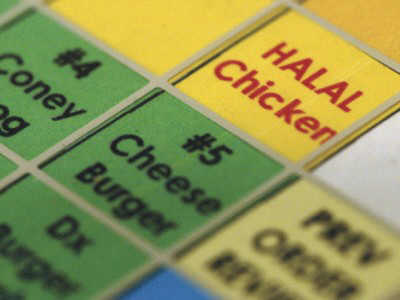
Globalization of Halal brand through Islamic country will be a successful
step towards having unified Islamic markets, after linkage of Islamic markets
together the opportunities of trade and investment will increase. In an
international level of trade, Muslimcustomers need to know about whether the
supplied goods are Halal or not. Pointing to the role of Islamic Chamber
Research Information Center (ICRIC) in the field of Halal food, this center
has tried to utilize the experiences of all the countries in order to help the
process of producing and supplying food to be done with a unique brand. Halal
brand will be a practical step for activating Islamic markets and through this
way exportation to other countries will be increased. According to the
reliance of people to Islamic Republic of Iran, the government will have
control over every product and will also have control on food production,
importation and exportation to be Halal any way. Islamic Chamber Research and
Information Center (ICRIC), affiliated to Islamic Chamber of Commerce and
Industry (ICCI) and a member of the family of Organization of Islamic
Conference (OIC) has embarked to study and research on the subject to meet this
need in Muslim world. ICRIC also has embarked to adapt a monitoringsystem in
“Halal Product” including “Halal Food” through adding up the implemented
activities in thisground. ICRIC wishes to register the “Halal” brand as well as
to develop an especial monitoring system for it by the help of Halal producers
in Muslim world. Moreover ICRIC wishes to support the development and expansion
of such Halal product by setting up a number of fairs and exhibitions, and in
its next steps, it could bring about other kinds of supports for such
manufactures at the global stage. Halal standard and label will make shopping
easier for consumers and it will also make it easier for food producers to enter
the Halal market. By following certain rules, producers will be able to obtain a
Halal certificate that is recognized worldwide, allowing them to expand their
sales opportunities. Considering the export of Iranian products, using of Halal
brand is necessary and cause the world market to be inclined to Persian Foods.
In the last year, the export of Iranian food products was $260 million and due
to the high potentials of Iranian companies in producing Halalproducts, it is
predicted that food export will be increased over $700 million.
|
|
|
The Iranian natural spice as called Red Gold is saffron |
Saffron is the most precious and expensive spice in the world. Purple- flowered saffron is a wonderful plant to which nature has given a fascinating fragrance, pleasant flavor, a beautiful color, and a host of other qualities. Believed to have been originally native to the Mediterranean area, Asia Minor and Iran, the saffron crocus has long been cultivated in Iran and was taken from this country to other parts of the world as a result of trade, after its high quality and distinctive properties were understood over centuries of this application. Treasured for its golden- colored, pungent stigmas, which are dried and used to flavor and color foods and as a dye, saffron cultivation is a particular Iranian agricultural product whose method of producing and preserving used to be an unspoken secret for many years in the hearts of the Iranian farmers who tried to limit its cultivation within the confines of their own lands so that in this way they could keep its near monopoly.

Iran is among regions where saffron was cultivated for the
first time, and its cultivation development in other parts of
the world is regarded as a consequence of wars and conquests by the Muslims,
some products which were cultivatable in territories under Muslim influence
were taken there for cultivation about 961 AD. Saffron is mentioned in an
English leech book, or healing manual of the 10th century but may have
disappeared from Western Europe until it was reintroduced by the crusaders.
Saffron is supposed to have been introduced into China by Mongol invaders who
took its bulbs from Iran. This fact is mentioned in the Chinese material
medica. (Pun tsaou 1552-78) Saffron plant has long and narrow leaves with no
petiole and grows directly out of its bulbs in dark green color. Its blossoms
are usually seen in individual form but also grow occasionally in clusters.
The saffron threads are the stigmas of the saffron flower, Crocus Stavus
Linneaus. Each flower contains only three stigmas. These threads must be
picked from each flower by hand, and approximately 170000 of these flowers are
needed to produce one Kg of saffron filaments, making it the world’s most
specious spice. Saffron is used both for its golden color and for its strong,
intense flavor and aroma. Saffron is available both in threads and powder.
Legitimate powdered saffron is red-orange and is made by grinding saffron
stigmas.

Saffron cultivation is done on a cyclical basis, and that, after the elapse of
seven to nine years, the land in question should be switched to another crop
such as grains for a period of approximately seven years so that the land can
restore its lost nutrients. Studies done on the production of saffron
indicate that the maturity or age of land has a direct bearing on the volume
of production, and that after the elapse of approximately seven years from the
outset of cultivation, the land’s productivity begins to decline. However,
the average harvest from each hectare of land is between 20 to 25 Kg under
normal conditions. Between the second and the seventh year, the production
would fluctuate from 5 to 20 Kg per hectare, and that from every 1000 grams of
flower, some one percent or 10 grams of saffron is obtained. Harvesting and
separating saffron stigmas require extensive manpower, and it is generally
regarded as a laborintensive endeavor, and very time consuming. It takes
approximately 370-470 hours of work to produce 1 Kg of dried saffron
threads. The harvesting includes three stages as follows:
1-The harvest of saffron crop begins with picking of the blossoms and separating the stigmas from them. The harvest period is traditionally from late September to late December. The process should begin early in the morning before sunrise, and the period within which the blossoms are at their maximum are from 15 to 20 days.
2- The stigmas thus collected are placed in shade in a warm and dried room for five to seven days in order to dry. In the past in some cases the drying was done in a ritual of roasting but now is done in factories which have the international standards such as ISO and HACCP. Drying is the most important part of the saffron production process. The drying process activates the chemical compounds, which release aroma, color and flavor. It is a delicate procedure which requires skill, great care and experience. If the crocus is dried properly it retains its distinctive properties, namely color and aroma.
3-And finally, after the stigmas are dried, they are packed
in different packing shapes and stored away from light and humidity.
Temperature, humidity, light and storage length influence the Saffron flavor
and characteristics. Saffron in proper packaging looses its flavor after three
to five years but its color remains. Saffron is very light- sensitive and
hygroscopic and must be stored in cool and dry environment and proper
packaging. It must be stored away from other spices and goods which are
sensitive to moisture/ humidity or release moisture (e.g. copra). The product
is therefore packaged in cans which are in turn packaged in boxes for
transport. Sometimes Saffron is packaged in corrugated board cartons lined
with aluminum. Standard packaging plays an important role in product
marketing. For the same reason, the industry can help enhance and add value
to the exports of Saffron, by means of quality packaging. Poor packaging has
marred the Iranian Saffron export industry in recent years, while only
boosting the volume of wholesale exports of Saffron products. On the other
hand, lack of suitable packaging and marketing practices has further damaged
the competitiveness of the quality of Iranian products in the world market.

For instance, high quality Saffron produced in Iran is exported in bulk and at
a very low price – mostly to Spain and UAE. The exported Saffron with its
unique quality and taste is then mixed and reprocessed with Spanish and
Portuguese Saffron before being packaged in beautiful designs. It is then re-
exported at very higher prices to all parts of the world. These countries even
put their own trademarks on Iranian Saffron they re- export. Improving the
industry of packaging and processing Saffron in recent years has lead to
proper marketing of this strategic commodity so successful investment on that.
Considering that Iran is prominent Saffron producer a strategic programming in
processing and packaging systems, marketing and adopting pivotal principles
of investment can put the trade of this commodity in its real position.
Considering the investments in marketing and conversional industries in the
Saffron industry the capacity of packaging system has reached 350 tons per
year in Iran. Due to the long experience with its cultivation and the transfer
of methods of growing and harvesting from person to person, or generation to
generation, Iranian saffron has managed to keep its distinctive qualities in
comparison to those produced in other regions of the world. That might also
explain why Iranian saffron enjoys such an exceptional recognition for its
fragrance, flavor and color at international markets. The coloring strength of
the saffron is influenced of red stigmas compared to the yellow or white parts
of the flower (known as the style). More yellow or white parts imply greater
floral waste and therefore lower coloring strength. This translates into
lower quality saffron with less flavor and aroma. In addition, there is more
deadweight associated with these lower quality saffron grades as the style has
no culinary value. Therefore less yellow and more red parts implies a higher
quality of saffron. The international organization for standardization (ISO)
has set a classification for saffron in terms of minimum requirements for
each grade of saffron. This ISO 3632 classification is the only method used
internationally to measure saffron worth. It stipulates that the minimum
coloring strength for category 1 saffron is 190.

The highest quality Iranian saffron is known as “Sargol
“(literally translate as “top of the flower “ ).
The equivalent Spanish name is “Coupe “. This contains only
the pure red stigmas of the saffron plant and therefore captures all the
aroma, flavor and dye. The Sargol saffron is cut and separated from style
prior to the dying process. This enables it to retain its pure red color and
results in a coloring index range of 220 to 250. “Pushal “grade (or La
Mancha) saffron is not cut like Sargol and
therefore contains more yellow parts from the style of the plant and higher
floral waste. This results in a slightly lower coloring strength of
approximately 220. The lower grade saffron contains higher properties of
yellow parts as the whole filament comprising the yellow style and the red
stigmas are included. Consequently the coloring strength for this grade is the
lower than the other two grades. Saffron has been used over the centuries as
a natural coloring and aromatic in food, pastries and drinks. Even though
saffron stigmas are red, their dye is the color of egg yolks. Saffron is used
in food industry for its natural golden color, taste and the aroma in some
products such as Macaroni, cheese, Ice cream and dehydrated soup which the
usage of saffron in food industry is increasing due to smell, color and aroma
of saffron, in addition usage of saffron in beverages such as sodas and other
drinks have been more serious nowadays specially in Europe. In general,
saffron can be used as an important ingredient of any customs of cooking from
fine dining to use in the household kitchen, with limitations in its use. As
a therapeutically plant, saffron is considered as an excellent stomach
weakness and an anti spasmodic helps digestion and appetite. It also relieves
renal colic, reduces stomachaches, and relieves tension. It is also used as
drug for flu like infections, depressions, hypatomegaly and as a sedative for
its essentials oils. It is also considered that in small quantities it
regulates women’s menstruation and helps conception. It is a fact that even
since antiquity, crocus was attributed to have aphrodisiac properties. Many
writers along with Greek mythology sources associate crocus with fertility.
Crocus in general is excellent stimulant saffron as an anti cancer. The use
of saffron in the cosmetic industry is now improving just because saffron is a
natural product for its aroma and reenoving pimples ease rashes and smoothing
face and skin. In old days in the Asia women were using saffron as a paste for
their beauty, which was valuable cosmetic for princess and rich people. For
its aroma and color is used as an oil base for perfumes which the perfume in
the Middle East is called “Saffron Attar “.As a perfume, saffron was strewn
in Greek and Roman halls, courts, theaters and balls. A survey of the regions
where saffron is grown will provide testimony to the fact that the knowledge
of cultivating was transferred from Iran to the other parts of the world. In
general, the cultivation centers of saffron are those regions which had
political and commercial contacts with Iran.
Iran is the biggest worldwide producer of saffron in terms
of volume and quality.
In general, since the cultivation of saffron requires strong sunshine and warm climate with clayey or sandy land, the eastern parts of Iran has an especially suitable environment for its cultivation. The main saffron cultivation areas in Iran are in the eastern and north- eastern of the country. The khorasan province regions have managed to achieve an excellent position on the production and export of saffron over the years; to the extent that some 90% of saffron production in Iran is obtained from there (It produced over 119 tons in the past year and is predicted to produce 130 tons in the current year). Ghaenat region in this province is well known for its quality saffron. Khorasan Razavi and South Khorasan provinces account for 86% and 14% of total Khorasan’s saffron production respectively. Yazd province has reached the second position in saffron production (It produces 2800 Kg per year).There is 600 hectares land under cultivation in this province, mainly around Tabas , Behabad , Mehriz ,Yazd and Ardakan,80% of its saffron production is exported due to its high quality. There are other regions in Iran with a history of cultivation but their productions have been mainly for domestic consumption with minor role in the country’s export. The provinces if Isfahan, Fars, Kerman and North Khorasan have reached the next positions in saffron production. It is predicted that about 200 tons of saffron be produced from 60000 hectares in the current year. Iran is the first saffron producer in the world and meets 90% of the world’s saffron needs. Spain is the second saffron producer and India, Singapore, Malaysia, Japan, Taiwan, China, France, Italy, Germany, Australia and Greece have not even reached the third position together. All world countries (except for Iran) produced only 18 tons of saffron in 2007. Iran exported about 38% of saffron to UAE, 32% to Spain, 7% to Saudi Arabia, 4% to Italy and 3% to Sweden. Spain is the second saffron producer and imports about 50% of its saffron from Iran and selling Iranian saffron under its own trademark. Spain produces only one ton of Saffron a year. Iran saffron exports exceeded $75 million in value (141 tons) from March 2006 to March 2007, registering a 21.7% growth compared to figure for the previous year. The figure is predicted to soar to 200 tons in the current Iranian year 1386( March 2007- March 2008).
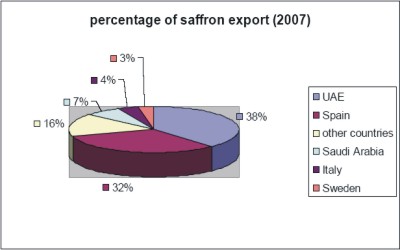
Azadeh Nikfarjam
|
Pomegranate, A Fruit From Heaven |
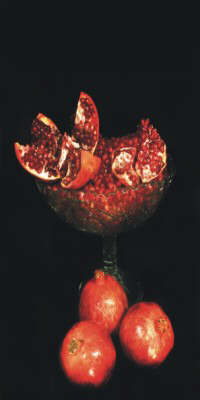 |
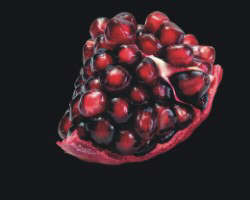 |
Azadeh Nikfarjam
Pomegranate is an Iranian ancient fruit. It is originated in Persia and has been cultivated in Georgia, Armenia and the Mediterranean region for several millennia. Even though this fruit is not originated from China, one common nickname is Chinese apple. Pomegranate is known as winter jewels and Red Ruby. In the global functional food industry, pomegranate is often mentioned among a novel category of exotic plant sources called “Super fruits”. It is a small tree up to five meter in height. The bark of the pomegranate tree is light down with red buds and young shoots. The leaves are small, opposite, glossy and almost evergreen. The large and attractive pomegranate flowers are orange-red. The fruit is between a lemon and a grapefruit in size. The characteristic large pomegranate fruits are crowned with a calyx and contain around 600 seeds in juice containing sacs. The seeds and surrounding pulp, ranging in color from white to deep red, called arils, are edible; indeed, the fruit of the pomegranate is a berry. There are some cultivars which have been introduced that have a range of pulp color such as purple. Pomegranates prefer a semi-arid mild-temperate to subtropical climate and are naturally adapted to regions with cool winters and hot summers. A humid climate adversely affects the formation of fruit. Pomegranates are drought tolerant and can be grown in dry areas with either a Mediterranean winter rainfall climate or in summer rainfall climates. In wetter areas, they are prone to root decay from fungal diseases. The pomegranate is equal to apple in having a long storage life. It is best maintained at a temperature of 0-5 centigrade (32 to 41 F).The fruits improve in storage, become juicer and more flavorful; may be kept for period of seven months within this temperature range and at 80 to 85 percent relative humidity, without shrinking or spoiling. At 95 percent relative humidity, the fruit can be kept only two months at 5 centigrade (41 F); for evidenced by faded, streaky pulp of flat flavor. They are tolerant of moderate frost, down to about _10 centigrade (14F). The tree can be severely injured by temperatures bellow-11.11 centigrade (12F). The tree adapts well to container culture and will sometimes fruit in a greenhouse. Pomegranates are also longlived.

The vigor of a pomegranate declines after about fifteen years. The pomegranate is self-pollinated as well as cross-pollinated by insects. Cross-pollination increases the fruit set. Wind pollination is insignificant. The pomegranate thrives on calcareous, alkaline soil and on deep, acidic range of soils in between these extremes. The fruit is nearly round, 2-1.2 to 5 inch. Wide fruit is crowned at the base by the prominent calyx. The though, leathery skin or rind is typically yellow overlaid with light or deep pink or rich red. The interior is separated by membranous walls and white, spongy, bitter issue in to compartments packed with sacs filled with sweety acid, juicy, red, pink or whitish pulp or aril. In each sac there is one angular, soft or hard seed. High temperatures are essential during the fruiting period to get the best flavor. The pomegranate may begin to bear in one year after planting out, but two and half to three years is more common. Under suitable conditions the fruit should mature some five to seven months after bloom .The fruit can not be ripened off the tree even with ethylene treatment. Growers generally consider the fruit ready for harvest if it makes a metallic sound when tapped. The fruit must be picked before over maturity when it tends to crack open if rained upon or under certain conditions of atmosphere humidity, dehydration by winds, or insufficient irrigation. The fruit ships well, cushioned with paper or straw, wooden crates or, for nearby markets, in baskets. Pomegranates are relatively free of most pests and diseases. Minor problems are leaf and fruit spot and foliar damages by whit flies, thrips, mealy bugs and scale insects. The roots are seldom bothered by gophers but deer will browse on the foliage. Pomegranate is said to be a heaven fruit. It has different chemicals, which fights against Emphysema, Cancer and slow downs the cellular aging process. Some of the compositions are anti-oxidants and exist in pomegranate oil. The sweet pomegranate juice reduces chest ache and cough. The sour ones reduce the effect of heart attacks. Pomegranate is full of vitamins C, B, A, E and different kinds of Iron form and other vital elements a diverse array of tannins- particularly hydrolysable tannins- and the most important anti-oxidants. Pomegranate also includes carbohydrates, acids, and minerals. Extract of pomegranate is also generally recognized as safe (GRAS) by FDA. Pomegranate juice includes sugar, tannin and mantin. It is up to three times more potent an antioxidant than green tea. It is rich in fiber, potassium and niacin. Pomegranate juice is a powerful antioxidant and may be useful in neutralizing harmful free radicals in the body. Free radicals contribute to many conditions, from aging to cancer. Wild pomegranate seeds are sometimes used as a spice, known as “anardana “ ,which literally means pomegranate (anar) seeds (Dana) in Persia, most notably in Indian and Pakistani cuisine but also as a replacement for pomegranate syrup in Persian and middle Easter cuisine. As a result of this, the seeds are separated from the flesh, dried for 10-15 days and used as an acidic agent for chutney and curry production. Many food and dietary supplement makers have found the advantages of using pomegranate extract (which have no sugar, calories or additives), instead of the juice, as healthy ingredients in their products. Many pomegranate extracts are essentially ellagic acid, which may only be observed into the body after consumption of punicalagins. In Iran, pomegranate juice is a very popular beverage. Most, simply, the juice sacs are removed from the fruit and put through a basket press. Otherwise, the fruits are quartered and crushed, or the whole fruit may be pressed and the juice strained out. Hydraulic extraction of juice should be at a pressure of less than 100 psi to avoid undue yield of tannin.
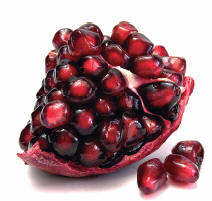
The juice from crushed whole fruit contains excess tannin
from the rind (as much as 1.75 percent) and this is precipitated out by a
gelation process. After filtering, the juice may be preserved by adding sodium
benzoate or it may be pasteurized for 30 minutes, allowed to settle for two
days, then strained and bottled. For beverage purposes, it is usually
sweetened. The juice sacs may be frozen intact or the extracted juice may be
concentrated and frozen. Pomegranate juice is widely made into grenadine for
use in mixed drinks. In the Asiatic countries it may be made into thick syrup
for use as a sauce. Juice of pomegranate has been found effective in reducing
heart disease risk factors and it has been shown to reduce systolic blood
pressure. The juice of wild pomegranate yield citric acid and sodium citrate
for pharmaceutical purposes. Pomegranate juice enters into preparations for
treating dyspepsia and is considered beneficial in leprosy. The bark of the
stem and root contains several alkaloids including isopellelieriene which is
active against tapeworms. Either decoction of the bark, which is very bitter
or the safer, insoluble Pelletierine Tannate may be employed. Overdoses are
emetic and purgative, produce dilation of pupila, dimness of sight, muscular
weakness and paralysis. All part of the pomegranate tree have been utilized as
source of tannin for curing leather. The trunk bark contains 10 to 25
percent tannin; theroot bark has 28 percent tannin content, the leaves 11
percent, and the fruit rind as much as 26 percent. The latter is a by-product
of “anardana” industry. Both the rind and the flowers yield dyes for textiles
and carpet. Ink can be made by steeping the leaves in vinegar. In Japan, an
insecticide is derived from the bark. The pale-yellow wood is very hard and,
while available only in small dimensions, is used for walking sticks and in
woodcrafts. Because of their tannin content, extracts of the bark, leaves,
immature fruits and fruit rind have been given as astringents to halt
diarrhea, dysentery hemorrhages. Dried, pulverized flower buds are employed
as a remedy for bronchitis. Leaves, seeds, roots and bark have displayed
hypotensine, antispasmodic and anthelmintic activity in bioassay. Due to the
vast usages of extracted tannin in industry, with establishing the tannin
center, can produce this material in the country and also can export it in the
future. In the world, production and consumption of pomegranate fruits are
increasing. The fact that pomegranate fruit has different industrial usage
fields such as fruit juice, conserve, vinegar, citric acid and medicine, lead
to its gaining popularity in the world market. Producing the processing
product of its fruit such as: pomegranate syrup, juice and extract, increases
three times its value added. Iranian pomegranates are among the best in taste
with red juicy arils and thin skin. It is natural and gardener produce
pomegranate without any chemical fertilizers and pesticides. An important
thing about Iranian pomegranate is the high diversity in the variety of this
fruit. Iran has lots of variety of pomegranate with different taste. The major
producers of pomegranates are Iran, Kazakhstan, Spain and United States.
Covering some 60000 hectares of lands and producing around 670000 tons of
pomegranates per annum, Iran has the first rank in
producing and exporting of this fruit in the world. Different
variety of pomegranate is produced almost in all parts of the country for
example in the valleys, hillsides or steps and grown in the form of dry
forming in the plains or in the large irrigated orchards. Pomegranates are
mainly produced in the provinces of Fars, Central, Yazd, Kerman and Khorasan.
The pomegranates produced in these provinces are highly demanded by European
countries. However, Fars province, enjoying 13000 hectares of lands under
cultivation (21 percent of total pomegranates under cultivation) produces
about 155000 tons of pomegranates – 23 percent of Iran’spomegranates
production per annum- and ranks the first and largest producer of the
commodity in the country by its foreign customers. The second province in
producing pomegranates is Central province with 7500 hectares of lands under
cultivation and producing 120000 tons pomegranates per annum. Khorasan Razavi
province has 7100 hectares of pomegranate lands and produces 88000 tons each
year. This province ranks the third producer in cultivating pomegranate. Yazd
province reaches the next position, having 6190 hectares of lands under
cultivation per yearwhich its 70 percent goes for internal market and 30
percent is for export. The next province is North Khorasan which has 124
hectares of pomegranate lands and 707 tons production.
Recent trends in the exports of the commodity are indicative of the fact that
Iran’s pomegranate export has steadily increased year by year. According to
the figures, over 150000 tons of the products were exported to different
European countries and to markets in Russia, Ukraine, Arab countries as well
as the central Asian countries. The main countries to which Iran exports its
pomegranate are: Britain, France, Spain, South Korea, Russia, Azerbaijan,
United Arab Emirates, Netherlands, Armenia, Turkey, Bahrain, ermany, Japan
and Ukraine.
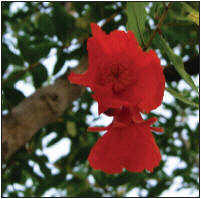
Like many other agricultural products, the export of Iran’s pomegranate is
facing numerous hindrances most important of which are the lack of a decent
transportation system, producers and exporters’ inadequate knowledge in the
field which prevents them from being familiar with the recent scientific and
modern methods in packaging, preserving and marketing. In order to increase the
level of production should rejuvenate and improve the old pomegranate gardens
in some provinces. Also establishment and put in operation the processing
pomegranate centers can improve qualitative and quantitative pomegranate
production and cause to flourish its exportation
|
|
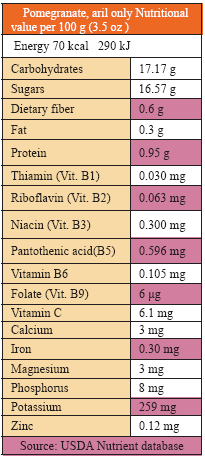 |